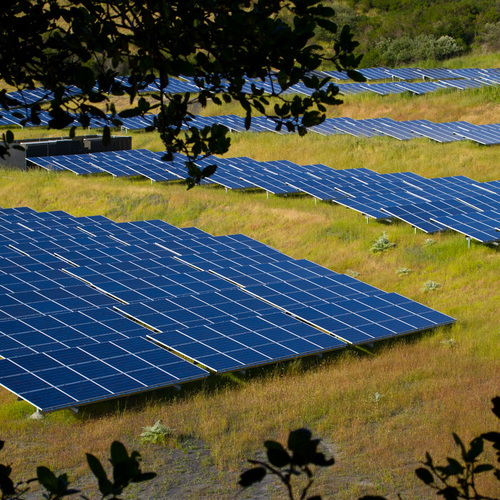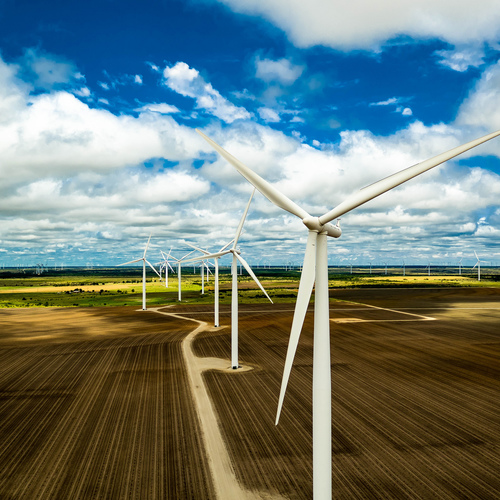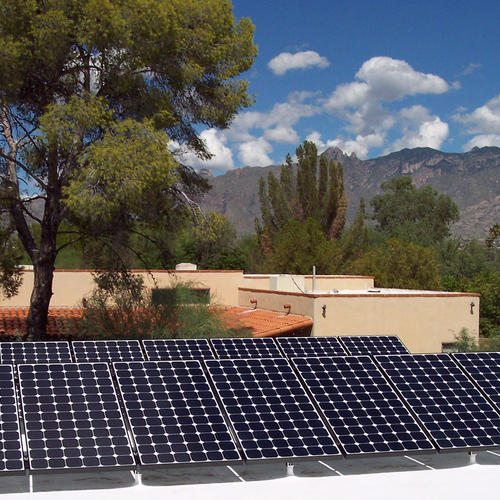
Federal tax credits for wind and solar systems are to be phased out beginning next year as part of a 2015 deal that ended a ban on crude oil exports. Now, a group of Democrats in Congress would like rework the plan and keep the subsidies in place, Bloomberg reports.
The 2015 agreement was a boon for renewables. A production tax credit for the wind industry, which had expired, was reinstated with a five-year phase-out to end next year. A 30% investment tax credit for photovoltaic systems also was given an extension, with a gradual reduction to begin in 2020 and go to zero in 2022.
But changes in the political landscape have prompted more than 100 Democrats to sign on to a letter urging that the tax benefits be given more time.
The April letter, addressed to the Ways and Means Committee Chairman Richard Neal, said that investments in clean energy would help the country address threats posed by climate change. It criticizes parts of the tax code that provide billions of dollars in subsidies, “many with no discernible rationale,” while leaving renewable energy companies high and dry.
Among the requests:
- Continued incentives for wind and solar energy as a way of helping the country transition to 100% clean energy.
- Clarify the tax code for energy storage technologies, which lawmakers said is key to modernizing the grid.
- Encourage the spread of electric vehicles and vehicles that run on alternate fuels by revising a cap on subsidies for manufacturers that currently kicks in when sales top 200,000 vehicles.
- Support the use of biomass and wood pellets for home heating.
- Support policies that would continue development of the next generation of biofuels.
“We are cognizant that Congress last extended many of these clean-energy tax credits with the understanding that they would eventually be phased out,” the letter reads. “However, for many of us who served in 2015 when that bipartisan agreement was reached, the facts on the ground have now changed demonstrably.”
The extensions were supposed to serve as a bridge to the implementation of the EPA’s Clean Power Plan, but the Trump administration has “fundamentally altered the framework by which the 2015 agreement was reached,” it says.
Reaction was mixed. Neal, a Massachusetts Democrat, said he favored an extension of the incentives. Senate Finance Chairman Chuck Grassley, a Republican from Iowa, does not. He said that he assured opponents of the wind tax credit in 2015 that he wouldn’t be back for another extension if they went along with it then.
Weekly Newsletter
Get building science and energy efficiency advice, plus special offers, in your inbox.















12 Comments
Motorweek just recently did a road trip in 3 EV vehicles they covered 710 miles in 13 hours plus 8.5 hours downtime for charging............how convenient 21.5 hours to travel 700 miles averaging 33 miles per hour....its literally stepping back in time to the early 1900's PROGRESS!
http://www.motorweek.org/features/auto_world/ev-road-tripping
Anyone who owns an EV knows they are a better fit for local driving, and as a second vehicle. For long distance, you can plan ahead and make stops where charging stations are located. Its all common sense, and a will to do it. The article acknowledges that.
That's true of 2019 models, but will probably not be true by 2025, given the rate of incremental improvements in battery technology, both on the capacity & energy fronts, as well as maximum charging rates.
One company is betting on being able to get their technology to the 600 mile+ per charge range in that time frame:
https://innolith.com/innolith-energy-technology-brings-1000km-ev-within-range/
Even if their product turns out to be vapor-ware, there is plenty of reason to believe that one of many others' efforts to make that level of improvement will happen by 2030.
The whole driving range thing is somewhat beside the point. Smart car chargers and the ability to use the automotive fleet as a controllable "virtual powerplant" load allows for much greater penetration of variable output generation such as solar or wind without the need for curtailment, soaking up the excess when there is over-generation. It doesn't take a huge fraction of the automotive fleet to be electric to make it happen, and it avoids the capitalization costs of large grid batteries to provide the same energy-sponge capacity. (And that's even without addressing 2-way power flows or how that would be paid for.)
Even if battery technology development were somehow frozen at today's performance levels, it's still "good enough" for most peoples' transportation needs, and as manufacturing volumes increase the price will drop to "no brainer" levels for new-car buyers within the decade. (Some would argue that they're already there, but while economic at current pricing it still requires doing the math, and thus the use of a brain.)
As for local driving, I don't think there is a better vehicle than an EV. I spend a total of 20 seconds of my time per week dealing with the charging cable. Sure beats the 10 minutes spent waiting at the gas station smelling fumes while refueling. No oil changes, no air filters, no exhaust, no vibration from the motor when driving, no gear shifts. I have friends who love that stuff, I prefer to listen to the music on the radio than the roar of an engine. And since local driving represents the vast majority of most driving, it might be more suitable to relegate the gas vehicle to the second vehicle status to be used for long trips.
I would also argue that if you have a Tesla, it is more suitable for longer trips than a gas powered vehicle. I drive to Boston a few times a year with the family. After about 2 hours of driving, we have to stop for bathroom breaks, food, leg stretches, etc. We have many Tesla Supercharges to choose from on that trip. Frankly we only need about 50 miles of range to get us where we need to go which takes less than 10 minutes of charging, about the same amount of time as a gas fill-up. Since we are stopping for lunch, we usually take 30 minutes which gives us 170 more miles of range than we had when we stopped. We stay at hotels in Boston that have their own chargers so when we leave we have full battery and we stop at the same Supercharger on the way back. Ever try to find a gas station in the city? Usually a PITA in a bad part of town, but not so with charging. But here is the real kicker, an EV so much more relaxing to drive. The lack of motor vibration has a noticeable difference on how you feel after a few hours of driving. I would be much more fatigued by the end of this trip in my gas powered SUV, but not anymore.
At the moment, Tesla really is the only game in town for long-distance driving thanks to their Supercharger network, but with virtually all of the other car manufacturers electrifying their vehicle line-ups, there will be more vehicles with longer ranges and more charging options in the near future.
And an average travel speed of 33 mph.
Most people buy vehicles that fit the whole family even if most of the time there is only the driver. Unless you want to make the case that two cars have a lower cost of ownership than one.
It's cheaper to rent the long-range car for family road trips that call for it, and keep the EV for the daily short to mid-haul use.
But single-car families are a minority- 57% of all US households have 2 or more cars, ~10% or so that have no cars. So it's really about 2/3 of families in the US with cars have 2 or more. At current technology/cost/ charging station limits it makes intermediate term financial and environmental sense for many 2-car families to have a battery-only EV for one of the cars and a plug-in hybrid for the other.
There is one such family in my neighborhood, with a Tesla Model 3 and plug-in Prius in the driveway. She has the longer commute and drives the Tesla, he can make it to & from work on battery alone with the Prius. They could arguably drive the Tesla on family trips utilizing Tesla's network of fast chargers, but for driving off into the boonies it may be easier to take the Prius. (I'm not privy to which car they actually take for long haul trips.)
At current trends in well under a dozen years charging times will be cut by more than 3/4, battery capacity doubled, all with falling up front costs. And that's only counting on the rate of incremental improvements, not counting on breakthrough technologies such as solid state electrolyte, etc, which seem likely to be coming eventually, with timing uncertain.
This kind of argument is like comparing a sedan to a pick-up truck by seeing how effectively you can haul stuff to the dump.
How many people try to drive 13 hours in one day, and how often? If I had an electric vehicle with a 300 mile range, it would cover me for 99.99% of my travels. That's every single commute, every day trip, and most vacations. If I wanted to go on a road trip where I covered more than 300 miles a day, I'd rent a vehicle. This might happen once every few years, probably even less than that. Just like I wouldn't have to buy a pick up truck because I might make a trip to the dump one day, I am not limited to a gas powered vehicle because of some other rare event.
Right tool for the right job.
If I was driving to Florida, I'd take our Caravan minivan (ie. gas). I take my Leaf every day to work on my 180km round trip commute.
I don't complain when my sledge hammer makes a poopy hammer to pound in finishing nails. Much like sizing a mini-split for the majority of cases, I "sized" my vehicle for the majority of my driving needs.
But happy capitalism to everyone; choose what works for you and what you're willing to pay for.
Looks like Motorweek chose those cars to reach the conclusion their readers wanted to hear, otherwise they would have done it in a Tesla.
Was it what their readers wanted to hear?
Could it have been what some of their advertisers wanted to hear?
I wouldn't presume either to be the case, nor would I rule either out.
The advertisers know their target market, so probably both.
More and more market distortions because politicians refuse to charge for the pollution caused by fossil fuels.
Log in or create an account to post a comment.
Sign up Log in